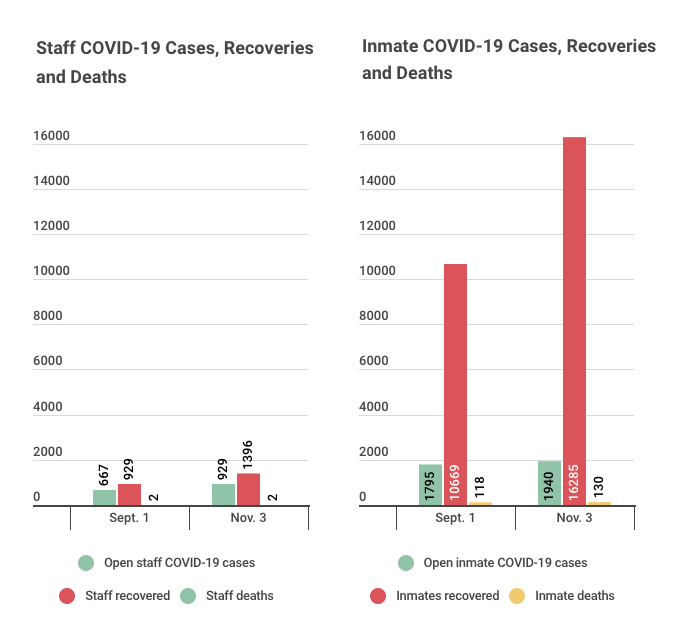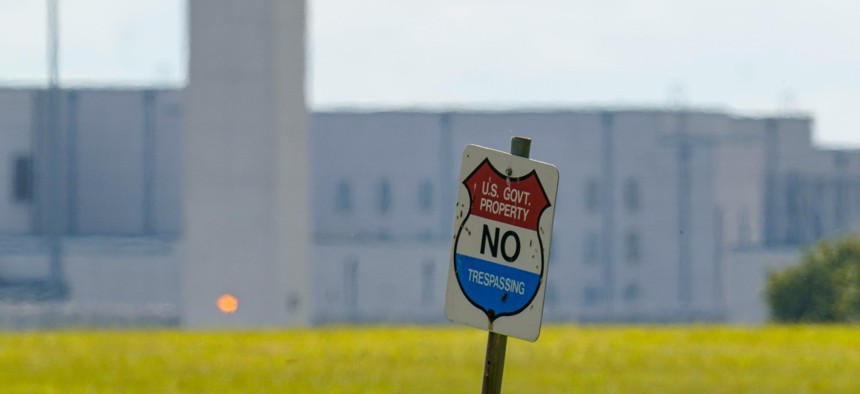Federal Prison Agency Says It’s Protecting Staff and Inmates From COVID-19 During Social Visits, Amid Concerns
Cases have increased among staff and inmates, provoking fears from employees and union officials.
The Federal Bureau of Prisons is confident it’s mitigating the spread of the novel coronavirus throughout its facilities during social visitations for inmates, which have been allowed for at least a month now. However, some union officials and employees have misgivings as the number of coronavirus cases among staff and inmates has increased.
After suspending social visitations on March 13 as part of its initial pandemic response, BOP instructed its 122 facilities on August 31 to begin devising plans to resume social visits for inmates by no later than October 3. The plans needed to comply with health and safety precautions to prevent the spread of COVID-19. From September 1 to November 3, the number of open coronavirus cases for inmates increased from 1,795 to 1,940, recoveries increased from 10,669 to 16,285 and deaths increased from 118 to 130. As for staff, open cases increased from 667 to 929, recoveries increased from 929 to 1,396 and there were two deaths as of each date, according to BOP’s data, as shown by the graph below.

“The BOP is committed to protecting the health and welfare of those individuals entrusted to our care, as well as our staff, their families, and the communities where we live and work...Correctional institutions [have] made plans consistent with their resources (including physical space) and will continuously monitor their visiting plans,” BOP spokesman Justin Long told Government Executive on Tuesday. “Institutions will make prompt modifications, as necessary, to effectively manage COVID-19. Such modification may include limiting or postponing visitation, providing visitation by appointment or other adjustments as appropriate.”
He also said the number of coronavirus cases for staff and inmates is “fluid as it is among communities throughout the country” and the agency “continues to implement stringent mitigation strategies in accordance with [Centers for Disease Control and Prevention] guidelines.”
However, the visitations are sparking concerns among those working inside the facilities and members of the union that represents BOP employees.
In contrast to nursing homes, which have started to gradually reopen, following recommendations from the Centers for Medicare and Medicaid Services, BOP “opened without concern of safety for staff and inmates,” said Joe Rojas, the Southeast regional vice president at the Council of Prison Locals, a division of the American Federation of Government Employees. “Let that sink in.”
Brandy Moore, national secretary treasurer for the Council of Prison Locals C-33, said she believes the number of inmate cases could be higher and said the agency is “not doing wide-spread testing,” for inmates and only testing those who show symptoms.
As of Tuesday, BOP said it’s tested over 70,000, which is about 56% of its total population of 125,559.
“The vast majority of institutions are doing visitations and I know they feel a lot of pressure from the inmate population,” she told Government Executive. “I know a lot of them probably think that they’re doing staff favors because the inmates haven’t had visits in quite some time and everybody from the beginning has been worried that the inmates might riot or whatever when they get a lot of their privileges taken from them and visitations are very important to them.”
For the most part, plexiglass dividers and things like that, which BOP instructed agencies to use, “[are] not very feasible” and “incredibly expensive,” Moore said. She said she has been seeing locations rely mainly on just spreading out the chairs/social distancing. While visits are probably “a little more safe for the inmates,” staff are more at risk because they’re “processing all these visitors in, whether it be 20 or 200, they’re touching all this stuff from all those individuals,” she said. “Who knows if they’ve had it or are asymptotic?”
Brian Shoemaker, president of AFGE Local 1405 who works at a high security penitentiary in Lee County, Virginia, hasn’t seen an issue with social visitations due to the remote location. However, he said a major issue is the vast number of innate transfers to his facility, which he believes has led to a spike in cases. From April to mid-October the location had between zero and nine inmate cases and then by November 1 they spiked to 66. The number of cases among staff vacillated between August and October, then reached a high of 13 on November 1, according to the Justice Department inspector general’s tracker.
When asked if he’s worried about visitations in other locations, Shoemaker stated, “Yes, I’m very worried about that” because of all the transfers. He noted that the community’s health care system is already being strained by the coronavirus, putting the penitentiary aside.
“As communities continue to open businesses and we move toward a more normal schedule of inmate movement and transfers, the possibility for increases in positive cases in our correctional institutions exists,” Long said. “As community case numbers have risen, it increases the risk of staff exposures from outside the institutions in which they work. Measures to screen staff prior to entrance are in place to prevent potentially COVID-19 positive staff from introducing the virus within the institutions.”
Another BOP employee raised the concern that facilities might not be enforcing the policy that inmates and their visitors can’t have any physical contact.
“If they have zero tolerance for the 'Prison Rape and Elimination Act' and sexual harassment or any kind of harassment throughout the Federal Bureau of Prisons and they’re supposed to have no contact visits, then why is it when they have contact in the visiting room that supervisors ignore their own policies of zero tolerance ... and do not enforce their own regulations: require inmates to quarantine, [do] incident reports and remove the visitor from the visiting list,” an officer in BOP’s Southern region told Government Executive.
The agency also pushed back on these various points of contention, saying it increased testing for inmates as more resources have become available since the onset of the pandemic (noting there has been a “steep decline” in inmates needing ventilators, hospitalizations and deaths since May), has been adhering to the CDC’s guidelines, issued guidance to staff on what precautions take during visits and emphasized the benefit of social visitations for inmates’ mental well-being.
“I do see the other side of it because they are human and this is one of the biggest things that BOP nationwide has utilized to take privileges and give privileges in order to get inmates to act the way that they’re supposed to and behave,” Moore said. “But it’s just a hard pill to swallow for people to see that,” as many “non-incarcerated individuals [can’t] see their family.”








